一个基于 2-(2-羧基苯基)-1H-咪唑并[4,5-f][1,10]邻菲啰啉配体的二维铅ギ配合物的水热合成及晶体结构
2013-10-17刘春波车广波王诗朦白红叶史发年
张 青 刘春波 车广波*,,2 王诗朦 白红叶 史发年
(1江苏大学化学化工学院,镇江 212013)
(2环境友好材料制备与应用教育部重点实验室,四平 136000)
(3阿威罗大学化学学院,阿威罗 3810193,葡萄牙)
0 Introduction
The rational design and construction of new coordination polymers based upon assembly of metal ions and multifunctional organic ligands is an interesting research field because of their intriguing structural diversities and potential applications in gas storage[1-3],catalysis[4-5],magnetic[6-7]and photoluminescent materials[8-10]and so on.Though a great deal of coordination polymers with interesting structures and topologies have been investigated and reported,it is a long-term challenge to control the syntheses of coordination polymers,for the reason that many factors play a key role in their self-assemblies,such as the chemical structures of the ligands,the metal,the anions,reaction temperature and pH value[11-13].Among the ligands,1,10-phenanthroline(phen)and its derivatives(such as DPPZ[14-15],PTCP[16-17]and Pyphen[18-19])are good choices for constructing supramolecular architectures because of its excellent coordinating ability and large conjugated system that can easily form π-π interactions[20-25].However,to the best of our knowledge,little attention has been given to the phenderived carboxylic acids[26-28].We are interested in the 2-(2-carboxyphenyl)-1H-imidazo[4,5-f][1,10]phenanthroline (HL)ligand (Scheme 1),which contains chelating nitrogen atoms and chelating/bridging carboxyl group that can coordinate with metal ions in different modes,leading to the formation of various metal-organic framworks.Herein,we describe the synthesis,crystal structure,thermogravimertic analysis(TGA)and photoluminescent spectrum of the novel coordination complex of formula[PbL2]n(1)with leftand right-handed helical chains.
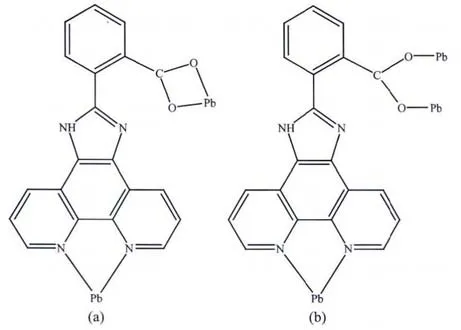
Scheme 1 Coordination modes of HL ligand(a)L1,(b)L2 in complex 1
1 Experimental
1.1 Generals
All the materials were analytical reagent grade and used without further purification.Elemental analysis was carried out with a Perkin-Elmer 240C analyzer.IR spectrum was collected by Fourier transform infrared spectrometer Nicolet Nexus 470.TGA was carried out under air condition on a NETZSCH STA 449C analyzer.Photoluminescent spectrum was obtained from Fluorescence spectrophotometer CaryEclipse while the complex was solid-state.
1.2 Synthesis of[PbL2]n
The title complex was prepared from a mixture of Pb(NO3)2(0.2 mmol,0.066 2 g),HL(0.1 mmol,0.034 0 g)and H2O(10 mL),the pH value was adjusted to 8 by addition of NaOH solution (1 mol·L-1),and the resultant solution was heated at 453 K in a 25 mL Teflon-lined stainless steel autoclave under autogenous pressure for 3 d.Cooling slowly to room temperature,the yellow block crystals of 1 suitable for single crystal X-ray diffraction analysis were obtained.The crystals were filtered,washed with distilled water and dried at ambient temperature to give a yield of about 47%based on Pbギ.Anal.Calcd.for C40H22N8O4Pb(%):C,47.57;H,2.18;N,11.10,Found(%):C,47.50;H,2.27;N,13.20.
1.3 X-ray structure determination
A single crystal of the title complex with dimensions of 0.105 mm×0.103 mm×0.100 mm was selected and mounted on an Bruker-AXS Smart CCD diffractometer with graphite-monochromated Mo Kα radiation(λ=0.071 073 nm)by using an ω-2θ scanning method at 292(2)K.In the range of 1.53°<θ<26.04°,a total of 22 252 reflections were collected and 6 050 were independent with Rint=0.029 0,of which 5 067 were considered to be observed(I>2σ(I))and used in succeeding refinement.The structure was solved by direct methods using the program SHELXS-97[29]and refined by full-matrix least-squares techniques against F2using the SHELXL-97 crystallographic software package[30].All non-hydrogen atoms were refined anisotropically and hydrogen atoms were refined isotropically.The detailed crystallographic data and structure refinement parameters are summarized in Table 1.

Table 1 Crystallographic data and structure parameters for complex 1
CCDC:900402.
2 Results and discussion
2.1 IR spectrum
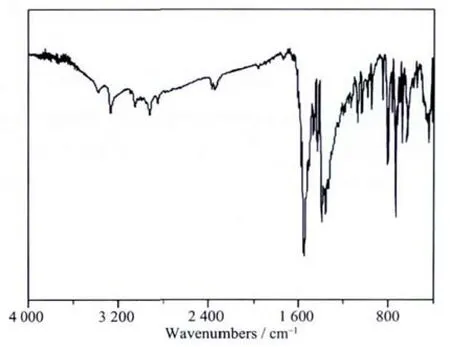
Fig.1 IR spectrum of complex 1
For complex 1,the COO-is coordinated with its asymmetric and symmetric stretching appearing at 1 550 cm-1(νas(COO-))and 1 390 cm-1(νs(COO-)),respectively(Fig.1).The Δν(νas(COO-)-νs(COO-))is 160 cm-1(<200 cm-1),showing the presence of bidentate chelating coordination mode of carboxylates in the complex.The δC-Hpeaks have a red shift from 853 and 737 cm-1to 808 and 729 cm-1which shows that two N atoms in HL ligand are coordinated with Pb ion.The weak peaks around 3 000 cm-1are the νN-Hvibrations of imidazole ring.
2.2 Description of crystal structure
The selected bond lengths and angles are listed in Table 2.Complex 1 possesses a two-dimensional structure that crystallizes in P21/c space group.The asymmetric unit of 1 (Fig.2)consists of one Pb2+ion and two L ligands(L1 containing O1and O2atoms,L2 containing O3and O4atoms).The Pb2+ion is an octacoordinated geometry environment by four nitrogen atoms from L1 and L2 ligands with the Pb-N bond distances in the range of 0.267 5(3)~0.287 7(3)nm,four oxygen atoms belonging to three carboxyl groups from one L1 ligand and two L2 ligands with the Pb-O bond lengths ranging from 0.241 8(2)~0.286 6(2)nm,in which O1,O4,N1and N6atoms are coordinated with Pb by weak interaction.All the bond lengths are near to the reports[31-32].Notably,the carboxyl group of HL ligand shows different coordination modes in complex 1.L1 ligand adopting a μ2-ηN2∶ηO2mode in N,N-chelating and O,O-chelating fashion while L2 ligand coordinates to three Pb atoms by N,N-chelating andO,O-bidentate mode (shown in scheme1).The Pbギatoms are linked by L1 ligands to form 1D helical chains along the b axis,and the adjacent helical chains are turned out to be left-handed and righthanded alternately (Fig.3).Then L2 ligands connect the contiguous helical chains further to form a 2D layer structure(Fig.4).
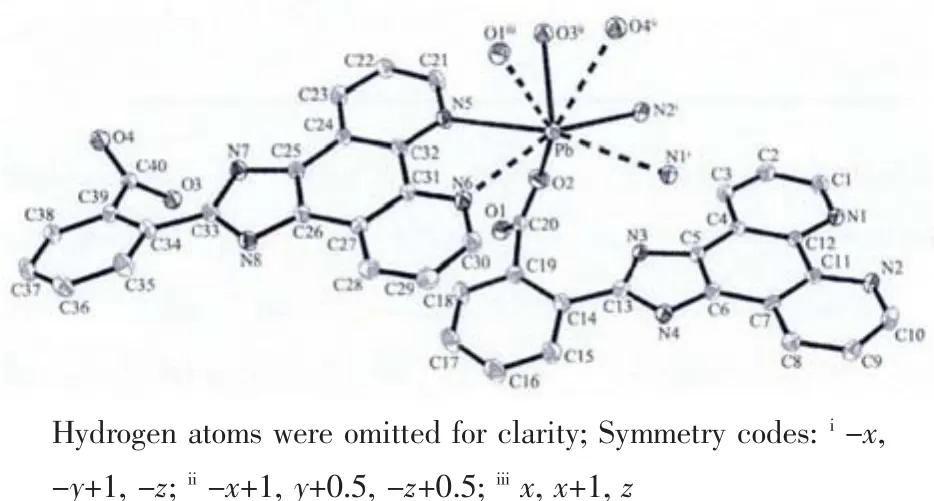
Fig.2 Coordination environments of Pbギatoms in complex 1 with displacement ellipsoids at 30%probability level
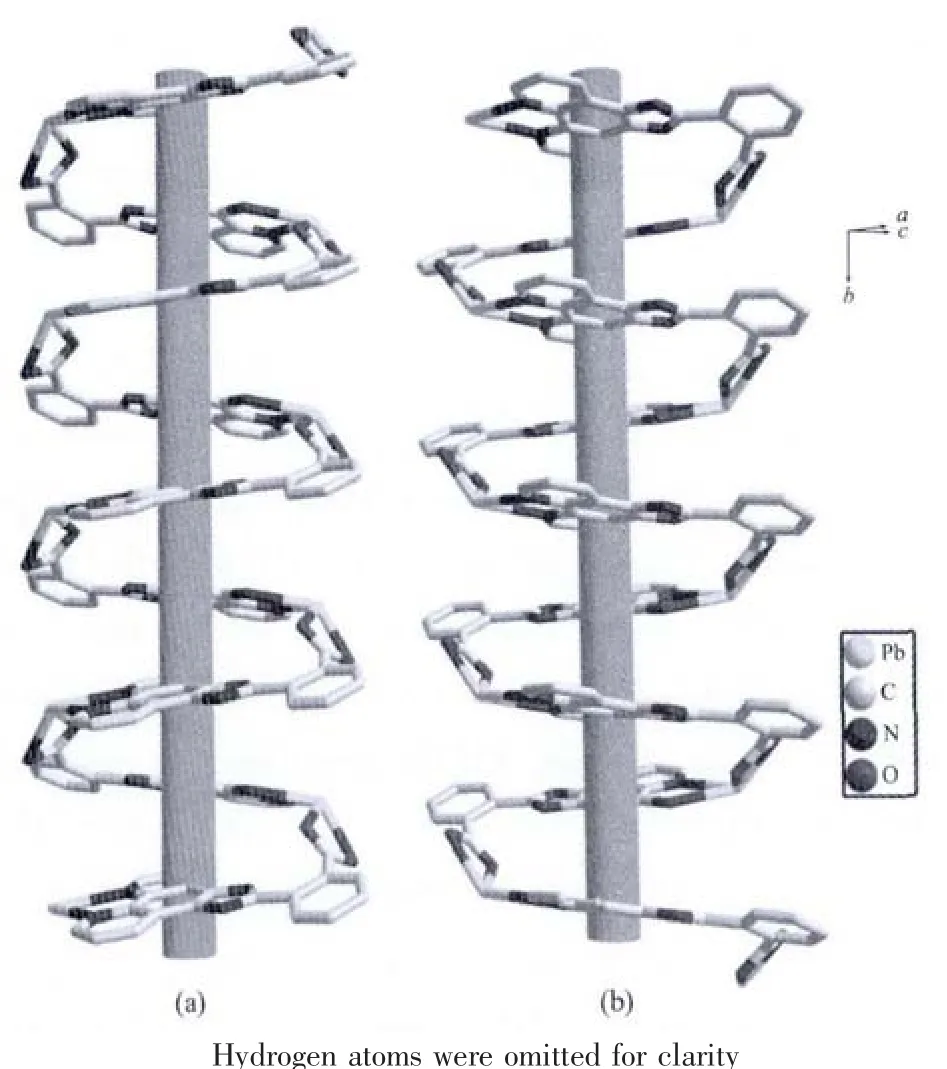
Fig.3 Adjacent 1D right-handed(a)and left-handed(b)helical chains
2.3 Powder XRD and thermogravimertic analysis
In order to substantiate the phase purity of the measured complex 1,its powder XRD was performed before the TGA and photoluminescent properties were measured (Fig.5).The experimental powder XRD pattern is in good agreement with the corresponding simulated one exceptfor the relative intensity variation becauseofpreferred orientation ofthe crystal.

Fig.4 2D layer structure of complex 1

Fig.5 PXRD spectrum of complex 1
To estimate the stability of the complex 1,TGA was carried out.The experiment was performed under N2atmosphere with a heating rate of 10℃·min-1in temperature ranging from room temperature to 900℃.As shown in Fig.6,the anhydrous complex 1 is thermally stable up to around 300℃.The first weight loss corresponds to the release of the carboxylate groups of L ligands in the temperature range of 316~428 ℃ (Obsd.9.94%,Calcd.10.71%).The second weight loss from 477 to 755℃can be attributed to the decomposition of the rest part of L ligand,the final product may be PbO.This result is in good accordance with the composition of the complex.
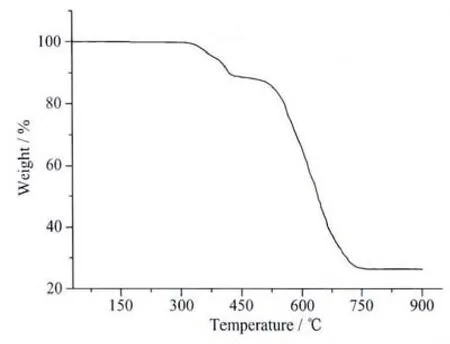
Fig.6 TGA curve of complex 1
2.4 Luminescent property
The solid-state PL spectrum of complex 1 is depicted in Fig.7. Free HL ligand displays a photoluminescent emission at 530 nm upon excitation at 470 nm[27].Compared to the free ligand,the strongest emission peaks for 1 are at 636 nm(excitation at 468 nm),and the emission arising from the free ligands are not observable for the complex.This emission of 1 could be originated to a metal-centered transition involving the s and p metal orbitals,as proposed by Vogler et al[33].
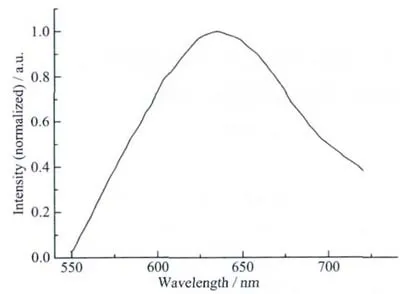
Fig.7 Solid-state PL spectrum of complex 1
[1]Hou C,Liu Q,Sun W Y,et al.Inorg.Chem.,2012,51:8402-8408
[2]Ma S Q,Zhou H C.Chem.Commun.,2010,46:44-53
[3]Férey G.Chem.Soc.Rev.,2008,37:191-214
[4]Marandi F,Nikpey Z,Khosravi M,et al.J.Coord.Chem.,2011,64:3012-3021
[5]Jacquelie L,Harding,Melissa M,et al.J.Am.Chem.Soc.,2012,134:3330-3333
[6]Zhang W X,Xue W,Chen X M.Inorg.Chem.,2011,50:309-316
[7]Lee S J,Lin W.Acc.Chem.Res.,2008,41:521-537
[8]Marandi F,Nikpey Z,Khosravi M,et al.J.Coord.Chem.,2011,64:3012-3021
[9]Łyszczek R,Mazur L.Polyhedron,2012,41:7-19
[10]Dong L J,Chu W,Zhu Q L,et al.Cryst.Growth Des.,2011,11:93-99
[11]Dinolfo P H,Hupp J T.Chem.Mater.,2001,13:3113-3125
[12]Blake A J,Champness N R,Hubberstey P,et al.Coord.Chem.Rev.,1999,183:117-138
[13]Wang X L,Qin C,Wang E B.Chem.Commun.,2004,4:378-379
[14]Liu C B,Gao L,Li X Y,et al.Chinese J.Struct.Chem.,2011,30(2):262-266
[15]CHE Guang-Bo(车广波),LI Xiu-Ying(李秀颖),XU Zhan-Lin(徐占林),et al.Chinese J.Inorg.Chem.(Wuji Huaxue Xuebao),2009,25(03):556-559
[16]WANG Xiang-Cheng(王湘成),LIU Chun-Bo(刘春波),LI Xiu-Ying(李 秀 颖 ),et al.Chinese J.Inorg.Chem.(Wuji Huaxue Xuebao),2010,26(11):2126-2130
[17]WANG Qian-Qian(王倩倩),LIU Chun-Bo(刘春波),LI Xiu-Ying(李秀颖),et al.Chinese J.Inorg.Chem.(Wuji Huaxue Xuebao),2012,28(3):619-625
[18]Wang X L,Zhang J X,Liu G C,et al.J.Solid State Chem.,2011,184:280-288
[19]Wang X L,Gao Q,Chen Y Q,et al.Z.Anorg.Allg.Chem.,2011,637:142-147
[20]Yang J,Ma J F,Liu Y Y,et al.Inorg.Chem.,2007,46:6542-6555
[21]Yang J,Li G D,Cao J J,et al.Chem.Eur.J.,2007,13:3248-3261
[22]Che G B,Liu C B,Liu B,et al.CrystEngComm,2008,10:184-191
[23]Li X Y,Liu C B,Che G B,et al.Inorg.Chim.Acta,2010,363:1359-1366
[24]Che G B,Wang J,Liu C B,et al.Inorg.Chim.Acta,2009,362:2756-2761
[25]Wang L,You W,You X Z,et al.Inorg.Chem.,2009,48:4295-4305
[26]Che G B,Chen J,Wang X C,et al.Inorg.Chem.Commun.,2011,14:1086-1088
[27]Wei Y Q,Wu K C,He J G,et al.CrystEngComm,2011,13:52-54
[28]Yang Z H,Xiong X F,Hu H M,et al.Inorg.Chem.Commun.,2011,14:1406-1409
[29]Sheldrick G M.SHELXL 97,Program for the Solution of Crystal Structure,University of Göttingen,Germany,1997.
[30]Sheldrick G M.SHELXL 97,Program for the Refinement of Crystal Structure,University of Göttingen,Germany,1997.
[31]Xu Z L,Ma X Y,Ma S,et al.Acta.Crystallogr.C,2010,66:m245-m248
[32]Wang X L,Guo Z C,Liu G C,et al.J.Coord.Chem.,2012,65:2634-2644
[33]Vogler A,Paukner A,Kunkely H.Coord.Chem.Rev.,1980,33:227-250
